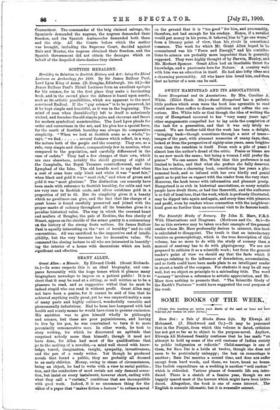SCOTTISH HERALDRY.
Heraldry in Relation to Scottish History and Art : being the Rhind Lectures on Archzology for 1898. By Sir James Balfour Paul, Lord Lyon King of Arms. (D. Douglas, Edinburgh. 10s. 6d.)—Sir James Balfour Paul's Rhind Lectures form an excellent apologia for his science, for in the first place they make a fascinating book, and in the second place the defence is based upon merits, such as its artistic possibilities, which are apparent to the most convinced Radical. If the "gay science" is to be preserved, let it be kept simple and beautiful, as it was in the beginning. The mind of man when (heraldically) left to itself is notoriously wicked, and forsakes the old simple pales and chevrons and fesses for modern symbolical monstrosities. The Lord Lyon pleads for order and correctness in the art, and his plea has a special force, for the merit of Scottish heraldry was always its comparative simplicity. "When we look at Scottish arms as a whole," he says, "we find several features which reflect, in a way, the nature both of the people and the country. They are, as a rule, very simple and direct, comparatively few in number, when compared to the population, and carefully differenced in the case of cadets." They had a few charges of their own, which are rare elsewhere, notably the shield gyronny of eight of the Campbells, the Royal Treasure counterflowered, and the Lymphad of the Isles. The old heralds used to say that when a coat of arms bore only black and white it was "most fair," when black and gold it was "most rich," and when of green and gold it was "most glorious." The distinction can scarcely have been made with reference to Scottish heraldry, for sable and vert are very rare in Scottish coats, and silver outshines gold in a proportion of 247 to 65. But its simplicity gives it a beauty which no gaudiness can give, and the fact that the charge of a great house is found carefully preserved and joined with the proper marks of cadency throughout all its branches gives it a peculiar historical value. The way in which the crowned heart and mullets of Douglas, the pale of Erskine, the fess cheeky of Stuart, appear on the shields of the minor gentry is a commentary on the history of the strong Scots noblesse. Sir James Balfour Paul is equally interesting on the "art of heraldry" and its odd conventions. All was sacrificed to the imperative end of intelli- gibility, but the very bareness has its decorative value. We commend the closing lecture to all who are interested in beautify- ing the interior of a house with decorations which are both significant and effective.


































 Previous page
Previous page